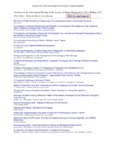Please use this identifier to cite or link to this item:
http://www.alice.cnptia.embrapa.br/alice/handle/doc/907385| Title: | Patch size controls selectivity of sheep grazing grass-clover grasslands. |
| Authors: | LACA, E.  GENRO, T. C. M.   BREMM, C.   GENRO, J.   SCHRIEFER, C.   |
| Affiliation: | EMILIO LACA, University of California, Davis, California, United States; TERESA CRISTINA MORAES GENRO, CPPSUL; Carolina Bremm, Universidade Federal do Rio Grande do Sul, Porto Alegre, RS, Brazil; JAIRO GENRO, Universidade Federal de Santa Maria, Santa Maria, Brazil; Craig Schriefer, University of California, Davis, California, United States. |
| Date Issued: | 2011 |
| Citation: | In: ANNUAL MEETING OF THE SOCIETY FOR RANGE MANAGEMENT, 64., 2011, Billings, MT. Abstracts... [Wheat Ridge: Society for Range Management], 2011. p. 392. |
| Description: | The trophic interaction between ruminants and grasslands is a fundamental process that shapes landscapes and modulates ecosystem function and productivity. Selective grazing can structure plant communities and thus, the control of selectivity can be used for ecosystems management. We hypothesized that selectivity for clover by sheep can be modulated by changing the degree of interspersion between grass and clover patches. We built 34 x 17 m pastures and modified their vegetation by seeding subclover and using selective broadleaf and grass herbicides to create either four 8.5 x 17 m rectangles or seventeen 2 x 17 m bands dominated by grass or clover. Pastures were grazed in the spring with either four sheep for 12 days or 12 sheep during four days. We measured herbage mass before and after grazing, and observed activity (grazing or other) and location (grass or clover) from 6 AM to 8 PM and determined selectivity as the ratio of total sheep-hours grazing clover divided by sheep-hours grazing grass. Sheep grazed more time in clover than in grass, particularly in the large patches than in the bands (P=0.025, 2.9 vs. 1.4). We did not detect a significant difference due to number of sheep or interaction, but the test had low power due to small sample size. Herbage mass changes also reflected a strong preference for clover, particularly in large patches. These results provide further evidence to the literature that indicates that vegetation pattern can be used as a management factor to modulate plant-animal interactions. |
| Thesagro: | Pastagem Ovelha Trevo |
| Type of Material: | Resumo em anais e proceedings |
| Access: | openAccess |
| Appears in Collections: | Resumo em anais de congresso (CPPSUL)  |
Files in This Item:
| File | Description | Size | Format | |
|---|---|---|---|---|
| SRM2011abstractstitleindex.pdf | 3,6 MB | Adobe PDF |  View/Open |









